Early on, before I embraced the magic of hand tools, I had a different dream. I imagined that I’d have a fully outfitted workshop. In it would be the biggest and best woodworking machines and power tools. I wanted a table saw so I wouldn’t have to worry about sawing in a straight line. I wouldn’t ever have to learn to saw straight. At all.
Resisting the call of power tools
I was grounded in reality quickly, however, when I realized that my lifestyle would not accommodate such thoughts.
In other words, my corporate career did not jive with my ambitions as a woodworker. Or at least in the way that I originally thought. I was disappointed and felt that a big obstacle had been placed in my way.
At the time there was no way around it. I had no choice except to let that part of the dream go. No more thoughts of being the next Norm Abrams. I watched a lot of his shows. I learned a lot and enjoyed them. No shame. At all!
Travelin’ light
I traveled and moved a lot for my job assignments. And I lived in apartments. Small ones. At one time in my career, everything I owned fit in my compact car. I even rented a room in a sweet elderly woman’s home in the Texas panhandle for a time.
Still, no landlord was going to allow a table saw and other big, loud power tools on their property. I didn’t expect them to.
Even if I did have such a set up I could not carry this unwieldy kit with me every time I moved. That would be expensive and a lot of work.
As time went on, I knew it was for the best.
I compensated by treating myself to a small power hand drill one Christmas and circular saw on the next. I still use the drill. Rarely, the circular saw comes out if I ever need to cut a full sheet of plywood to size.
Increasingly, I have my measurements ready when I visit the lumber yard. Before it even makes it to my car, I pay to have that big board or sheet of plywood cut as I prescribe.
My interest in hand tools grew over time
I knew nothing about working with hand tools except for the occasional hammer, screwdriver, or wrench that I learned to use when I was a little girl.
Having such a tiny tool kit had its limitations. I could not undertake major projects without some difficulty.
However, the magic of hand tools is that they are mobile. I can move and store them anywhere without help. I can clean and maintain them with ease. Importantly, they can be disposed of or replaced rather quickly, if need be.
Ergonomically, I get a lot of exercise using hand tools. When I am paying attention to how I am working, my form and posture improve, too. Well, that’s how it feels to me.

Using hand tools creates less dust and noise, and reduces risk of serious injury. And using them requires slowing down, which ends in a less stressful day. I have more choice, too. I can quickly and safely adapt the size of my tool to the size of the work. That is the true magic of hand tools.
What we don’t know scares us
I thought that learning about and using hand tools was too difficult. And I did not know anyone who could show me how.
I looked for information. I did a lot of self-study, teaching myself. Of course, I made mistakes. Gradually, I got better at using the tools and understanding how each functioned. I read woodworking books and magazines. I watched videos online and asked questions at flea markets and just kept my eyes open.
How do you start your woodworking journey? Well, start right where you are. Use what you have until you can get the tools you need.
Remember when your first home-made spaghetti dinner cost a pot, strainer and other cooking utensils, pasta, sauce, meat, and spices? That meal totalled, maybe, $100? You’re committed now. Next meal, you have everything you need with very little additional expense.
It works the same way in woodworking. Get the tools as you need them. It may hurt at first to spend the money… just remember that first pasta dinner!
Here are a few starter tools for a toolkit:
- screwdriver (a real one, not the kitchen knife)
- hammer
- saw
- tape measure or ruler
- combination square
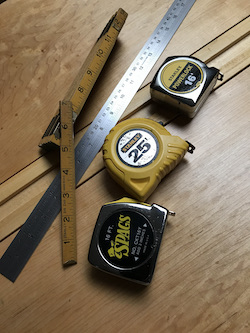
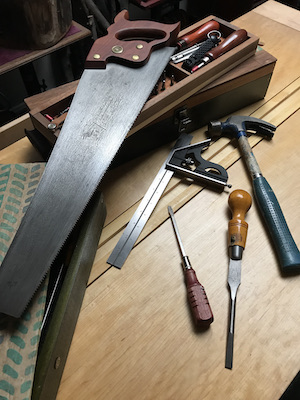
That’s it. Use your tools any chance you get for doing repairs and simple projects. Learn about your tools and how to properly use and control them. As you go further on your hand tool journey, your tool needs and wants will grow. First, perhaps, is a hand plane.
It doesn’t matter if the tools are old or new. What matters is that they are yours.
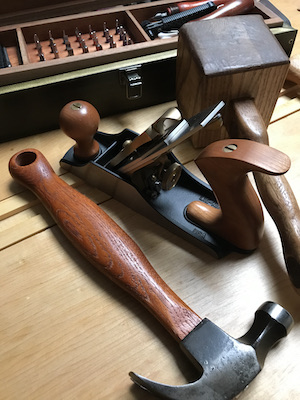
It just takes a little longer to do it this way. More practice and understanding leads to even more tools.
Remember, however, even paper cuts. When you handle any tool, safety is always first and common sense should not be far behind.
Lending and borrowing tools
I am not a lender of my tools. As time goes on, the relationship I have with them is quite personal. I clean them, I take good care of them and I need them to do my work. I like to think that I am not alone in feeling this way. As a result, I do not borrow tools, either.
“Neither a borrower nor a lender be;
For loan oft loses both itself and friend,
And borrowing dulls the edge of husbandry.”
– Polonius
(Hamlet, Act I, Scene. III)
Yes, it dulls the edges of the lent chisel, plane, or saw blade in the borrower’s hands. Unlike Polonius, however, I do heed my own advice.
Learning about hand tools
For me, the best resource for information on tools are catalogs issued by tool manufacturers. Obviously, these companies want to sell their products. Truth be told, I believe they know that many people don’t know how to use a lot of the tools in their own tool boxes.
I was one of them.
Woodworking, like other fields of interest, is constantly changing. A lot of times there is resistance to change. I am guilty of that, too.
I find that many, not all, new tools and techniques enhance the work shop experience.
It is no coincidence that companies distribute full color catalogs to educate and titillate in order to extricate money from our pocketbooks!
Much of the time it works.
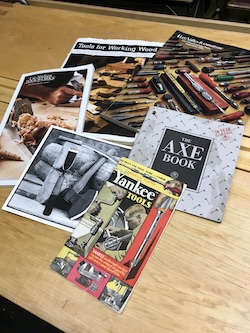
To this day, I continue my woodworking education by studying tool catalogs and other ephemera on the bus, train, and plane. I read about and study tools that I already have. I also study tools that I may never need, but it helps to absorb the methodology and history of the tools. This is empowering for me.
The knowledge I’ve gained from “reading” these catalogs helps me when picking tools at antique shops and flea markets. I have no fear negotiating with confidence for a good price for used, old, or even vintage tools.
I know what I’m talking about and listen with understanding when I meet vendors, makers, and fellow woodworkers at tool events, workshops, and classes. At best, I am at the same level as other buyers.
However, I am not getting up at 4 a.m. to go to the flea market. Wait! I have done that, but only in extreme cases…
S 💜

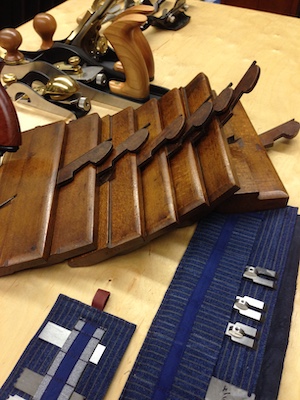
2 thoughts on “● The Magic of Hand Tools”
“How do you start your woodworking journey? Well, start right where you are. Use what you have until you can get the tools you need.”
Great advice for the journey of life, too! 💜
I agree. All great moves in life require that first step, then the next, and the next! Thank you for reading.